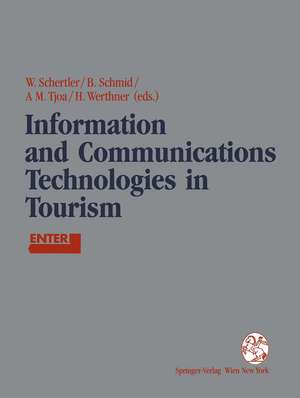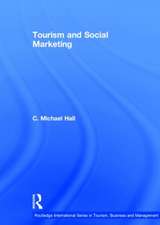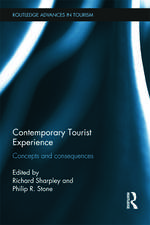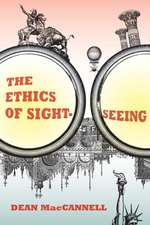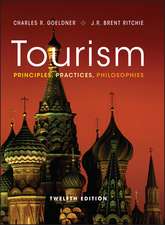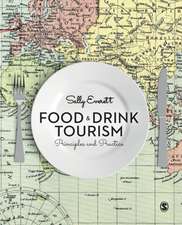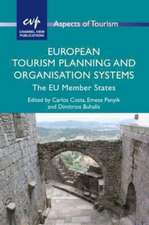Information and Communications Technologies in Tourism: Proceedings of the International Conference in Innsbruck, Austria, 1994
Editat de Walter Schertler, Beat Schmid, A Min Tjoa, Hannes Werthneren Limba Engleză Paperback – 2 ian 1994
Preț: 342.28 lei
Preț vechi: 427.85 lei
-20% Nou
Puncte Express: 513
Preț estimativ în valută:
65.49€ • 68.38$ • 54.21£
65.49€ • 68.38$ • 54.21£
Carte tipărită la comandă
Livrare economică 05-19 aprilie
Preluare comenzi: 021 569.72.76
Specificații
ISBN-13: 9783211825433
ISBN-10: 3211825436
Pagini: 304
Ilustrații: XII, 286 p. With online files/update.
Dimensiuni: 210 x 279 x 16 mm
Greutate: 0.69 kg
Ediția:Softcover reprint of the original 1st ed. 1994
Editura: SPRINGER VIENNA
Colecția Springer
Locul publicării:Vienna, Austria
ISBN-10: 3211825436
Pagini: 304
Ilustrații: XII, 286 p. With online files/update.
Dimensiuni: 210 x 279 x 16 mm
Greutate: 0.69 kg
Ediția:Softcover reprint of the original 1st ed. 1994
Editura: SPRINGER VIENNA
Colecția Springer
Locul publicării:Vienna, Austria
Public țintă
ResearchDescriere
The conference ENTER • International Conference on However, the tourist market has several specific characteristics Information and Communications Technologies in Tourism with regard to the use of technological infrastructure: represents a fll'St attempt • On the demand side computerized reservation and general • to provide an international forum for the discussion of the distribution systems (eRS and GDS), managed by big role of telecommunication and information systems in airlines, are well organized and technological pioneers. In tourism, the past they typically focused on the business traveller, • to inform potential users and people concerned with the nowadays they also try to cover the vacation sector. These importance of such technologies and to explain their systems work on a world-wide level and are highly functioning sophisticated. However, it should be added that the • to give an opportunity to the research community, nowadays information provided is rather poor and also selective, scattered into different areas of research, to discuss their which may restrict its usefulness for the promotion of an results on a common platform, and, fmally, entire tourist region. • to intensify the contact and the communication between • Similar to CRSlGDS several tour operators have begun to develop their own systems, although with varying success. researchers, system developers and users.
Cuprins
Invited Papers on Selected Topics.- Electronic Markets in Tourism.- Strategy and Information Technology in the Tourist Industry.- Tourist & Guest 2000.- Tourism 2000 — an Information Business.- Change Demands on Hotel Management.- TIS Tourism Information System for the Tyrol.- Telecommunication in Rural Areas.- Standard Specifications as the Basis for Sales-oriented Information.- Destination Marketing Systems.- Non-European Initiatives and Systems.- 1. Multimedia I.- Processing Travel Queries in a Multimedia Information System.- A Hypermedia Tourist Guide.- TIS/MM — Portugal.- 2. Multimedia II.- Can Tourism Be Replaced by Virtual Reality Technology?.- Anatomy of a Multimedia Project: Applying Multimedia to Public Transport and Tourist Information.- Using and Developing Hypermedia Points of Information: Lessons Learned.- 3. Multimedia III.- Development of a CD-ROM-based Multimedia-Application in an Open System Environment.- HyperTour: a Hypermedia Ecotouristic Information System for the National Parks of Costa Rica.- 4. Advice System I.- An Advice System for Travel Agents.- CABATA: Case-based Reasoning for Holiday Planning.- 5. Advice System II.- A General Train Connections Generation Procedure.- MaTourA: Multi-agent Tourist Advisor.- 6. Special Aspects.- A Hybrid Expert System for Avalanche Forecasting.- Distributed Quality Control: a Challenge for Software System Development.- 7. Tourist Information Systems.- Tourist Informationsystem Mühlviertel TIM.- The TIM Project: Tourism Information and Marketing.- 8. Organization Issues.- Information Systems and the Goals and Targets of the Organization: Fit or Misfit.- Strategies for Balancing the Competence-gap.- Scenarios for CSCW Applications in Tourism.- 9. Economic Issues I.- General Aspects of an Information System (IS) for Financial Justification of Investments in Tourism Marketing Information Systems (TMIS’s) Development.- Strategic Planning Tools Inside the Marketing-Information-System in Use by the Austrian National Tourist Office.- 10.Distributed Issues I.- Integrating Tourism Services Via Gateways.- 11.Distributed Issues II.- Improving Service in the Field of Tourism by Open Distributed Processing.- A Framework to Simulate Different Configurations of a Distributed Tourism Information Systems.- 12.Economic Issues II.- Information Technologies and Tourism Markets.- Types of Electronic Auctions.- 13.Software Engineering and Architecture.- Principles of Reference Models and the Linking to Object Oriented Systems.- Development of Adaptable Information Systems in Tourism.- Coordination Mechanisms and Systems Architectures in Electronic Market Systems.- 14.Computer Science Issues.- GFIRS: A Graphical Fuzzy Information Retrieval System.- A Heuristic Approach to Deal with the Scheduling Problem in the MO2 Distributed Model.
